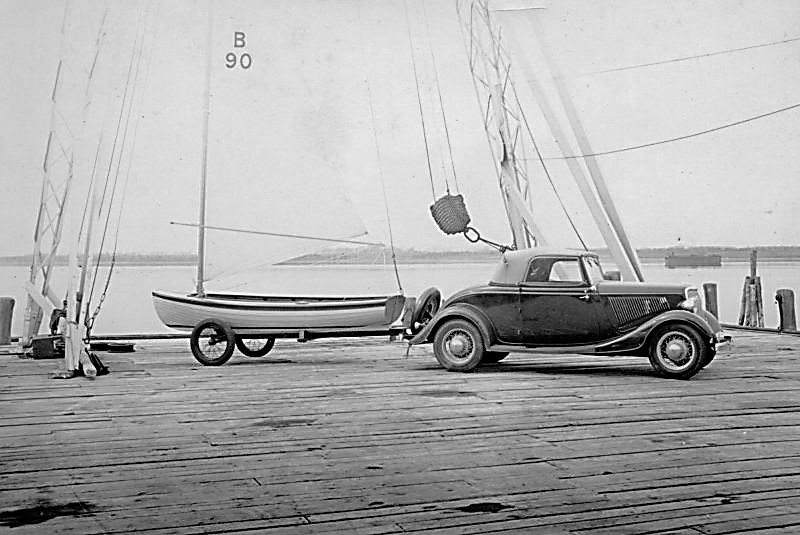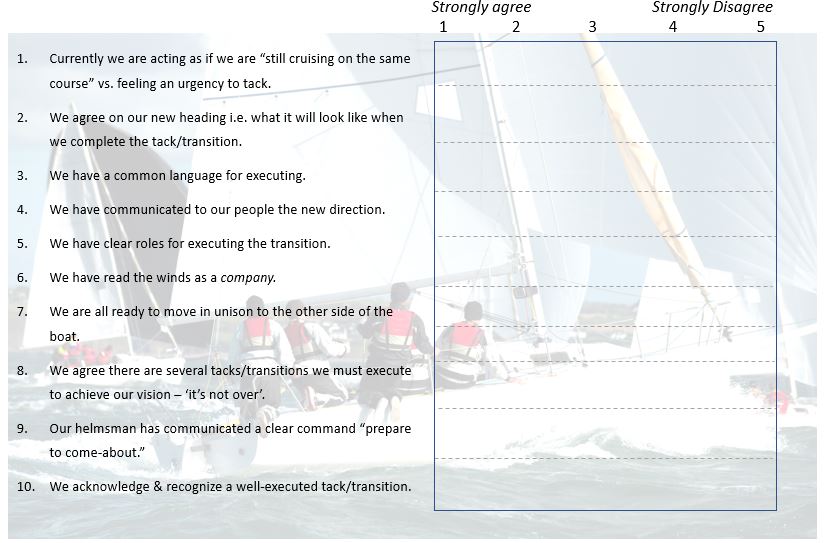I love to sail. I’ve sailed in familiar places like off the coast of California and around the Caribbean, but also along Croatia, in the Whitsundays in Australia, and the throughout the Pontines (the islands off Naples). I escape from everything when I’m sailing. It’s always genuinely renewing.
Most of the time island sailing is tranquil. You feel and hear the wind, the hum in the sails, and the water almost serenading you as you gently make headway. Until you need to tack in a stiff wind. Then it can look like chaos with lines whipping, sails cracking, winches yapping, bodies scurrying across the boat, and then all returns to a calm as you stabilize and sail on – until the next one.
I think sailing is a great metaphor for many aspects of leading a business but tacking especially so. As much as we’d like it to, a sail boat can’t usually sail directly to its endpoint due to winds. It must shift its position relative to the wind (move from the wind off your port side to your starboard side, for example) which feels counter-intuitive as you end up pointing away from your destination. And you repeat this maneuver several times moving back and forth across the wind. Ironically, tacking, if done well, maximizes your speed and efficiency. So it is with a business.
Tacking as a Metaphor for Transition Excellence
In business we might call tacking pivoting. Eric Reis defines a pivot as a “structured course correction designed to test a new fundamental hypothesis about the product, strategy, and engine of growth.” In business, as in sailing, we often must tack or pivot to keep moving forward. But we need to know how to do it well.
Tacking is Optional, Until it Isn’t
When and whether to tack are the call of a captain. As one captain related, when he was developing as a young sailor, he might tack 20 times, just for practice. The older he became, he bemoaned, the longer between tacks and the slower it all became.
What does a well-executed tack get you? Speed, efficiency of motion and less time to target, all of which are important when the sun is setting or your dinner on shore awaits, never mind if you are racing. When it’s sloppy, you not only lose speed, you can come to a stop aka being in irons. When the coordination of action is chaotic, people can be injured, lines tangled and sometimes equipment (like a winch handle) can find itself overboard.
Tacks, Pivots and Transitions
Business transitions entail tacks and pivots. They can be role and infrastructure transitions as a company moves through its growth curve requiring more centralized functions or perhaps a matrix. After a merger, integration means defining “one company” while not losing sight of unique cultures or business environments. Pivoting from one business model to another based on competitive pressures; shifting business metrics (from top- to bottom-line or to a balanced score card); changing the leadership profile (e.g. from command/control to delegation and engagement) are all critical transitions needed to arrive at a destination efficiently and with speed.
Tacking is a Discipline
What are the characteristics of a good tack? Here’s where there’s a special relevance to business. A tack, like a well-executed business transition, has an execution discipline made up of 6 requirements.
- Fully commit – you cannot hesitate or second guess your plan mid-tack.
- Have clear roles – it must be known who will be accountable for what tasks and people are prepared i.e. skilled.
- Use a common language – when the helmsman says, “Prepare to come about”, all hands know what that means and reply “Ready about”. There is a shared sense of urgency about the moment and the plan.
- Know the wind direction and its force – leaders have an external focus that tells them about the need for change and the extent of the change in direction.
- Use speed to keep speed and momentum:
- Turn the tiller/wheel hard – an effective captain knows that leading a transition needs a strong hand but not a rough one. Clarity, strength of conviction, and energy are key.
- Adjust the jib fast and efficiently – aligning the systems and structure of an organization is akin to a adjusting the sails – it must happen in-process not after-the-fact.
- Shift your crew together – leading transitions cannot succeed when some of the ‘crew’ are sitting it out in a ‘wait-and-see’ mode. A slow-to-change team member can impede progress, and they may find themselves tossed overboard.
- Never be complacent – a good leader, like a good sailor, never takes their environment for granted. Weather is like any disruptive force. It can shift almost instantly and the well-being and safety of one’s boat and crew require vigilance.
A “Captain’s” Transition Check List
I offer this check list for you to assess how well you are executing your business ‘tacks’, pivots, and transitions. Where would you see yourself on each of 10 transition leadership tasks? What does it suggest you must pay attention to as you head for your destination and calculate the tacks required.
The Joy Of Sailing – and Leading
If you don’t sail or haven’t experienced sailing, there is a beauty and peacefulness to being underway. It’s also full of adaptation, exhilaration, sometimes urgency, and occasionally the appearance of chaos. And you love it. If you own a company, you have no doubt experienced similar feelings about leading it. My advice, as a sailor, consultant and business owner is 1) sail close to the wind – it’s more interesting and effective and 2) be sure to step back from the fray and enjoy the experience occasionally. It’s renewing.
What are the transitions in your business
and how well are you executing?
Photo Credits: Historic Sailboat: from the Herreshoff Marine Museum / America’s Cup Hall of Fame; Boat underway with crew: Deposit Photos


